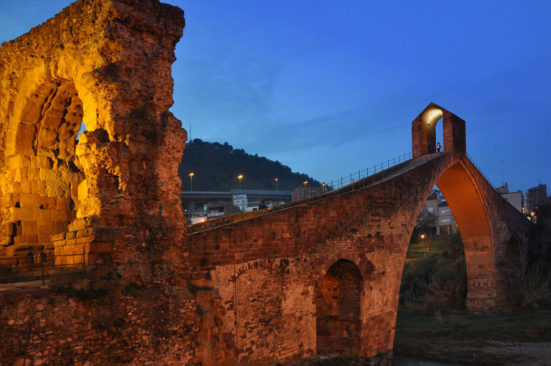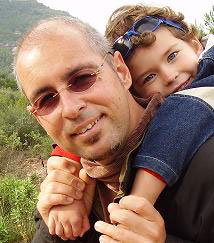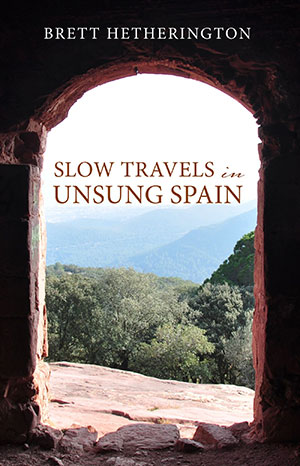
Puente del Diablo (The Devil’s Bridge), Martorell, Catalonia
“A compelling and eclectic narrative full of the unexpected”, is how Nick Inman from Rough Guides describes Barcelona journalist Brett Hetherington’s new book, “Slow Travels in Unsung Spain“.
Reading the book, I myself felt like a bird sitting on his shoulder, seeing all that he sees in wonderfully vivid detail. Because the following paragraphs are also funny as well as entertaining and informative, I chose them from near the end of the book where Brett tells us about what he finds after leaving Barcelona Sants station on RENFE’s Line 4…
An Extract from “Slow Travels in Unsung Spain”
“Heading for home, this train runs out through Barcelona’s ‘mean streets’ that never seemed quite so mean to me.
At L’Hospitalet I see cranes and huge sites being dug up: evidence of maybe some confidence finally coming back in the construction sector. These new buildings are rising up right next to those who have gone before.
Here’s a cemetery’s shelving system, the deceased placed one on top of the other with their tribute flowers, all open to see from the train window. Like so much else in Spain, the dead are not necessarily hidden away behind walls or fences but instead become a common feature of life, as it is experienced daily.
Very soon we stop at Cornella (also on the river and once prone to severe floods), another working class area.
I feel the cheer of mixed memories: very early in the morning walking through the November cold of a rundown industrial landscape, a happiness of independence in this grim world, and being free from the drudge of secondary school teaching for the first time in a decade and a half.
I picture the unemployment lines I’d see already forming outside the Social Security office near where the sewage smell comes up from the underground grates in the streets and recall that every Wednesday morning I would be here, just to teach English to the owner of a gasket factory.
In this area, my habitual RENFE train line follows the Llobregat River for a stretch. A small (unnamed) town somewhere on this river was the main setting for a subtle, engaging memoir titled An Unknown Woman.
Written by Lucia Graves (the daughter of English poet/novelist Robert Graves and translator of bestselling author Carlos Ruiz Zafón’s Shadow of the Wind), amongst many other telling observations in this work, she recollects how in the Franco years it was commonplace for the well-off Spaniard to order books “by the metre” simply to fill up shelves.
This habit suggested to me that their content was wholly unimportant to the householder, and that books were for decoration rather than something to nourish the mind.
We make our way past one of Barcelona Football [i.e. soccer] Club’s superb training grounds at Sant Feliu and then to Molins de Rei, a town named after the King’s Mills that once existed in this area. In the early twelfth century, mills were built here by order of the Aragon King Alfonso II (also called the Chaste or the Troubadour) a noted poet of his time and a close friend of King Richard the Lionheart.
I remember heading to work on a different day on this same train. I had read VS Naipaul’s note about Flaubert’s mill slaves being cruelly muzzled to stop them eating the flour they ground while dragging themselves around, pulling the wheel like beasts of burden in a never-ending circle.
I wondered what it was they milled here beside the river at a time when it must have had a more decent flow to it. Long ago in a different feudal era Catalan bread was made from crushed broad beans. Or maybe the king’s flour was made from corn, in a food habit stolen from a stolen continent: South America.
According to translator Peter Bush, “Catalonia’s industrial revolution started in the late eighteenth century with the manufacturing of textiles, and this meant that where there were rivers in the countryside there might be power to drive the looms, so you find factories in rural areas.”
It seemed to me that Molins de Rei was an example of a once rural town that now felt like it was the last part of the wider Barcelona conurbation.
Also along this train line, through a valley that makes a natural transport corridor, on the sides of buildings hundreds of business names can be seen.
And there are those that are odd and slightly comical to an English-speaker: Willi Betz; Fungilab; Uponor; SICK (Sensor Intelligence;) Robatech; Christher; Flippers International; Fagraf; Luk Fag; Praxair (slogan painted in green English words: “Making our planet more productive,” while its huge smokestacks belch out grey-white cloud); or Gonvarri (a traveller with a venereal disease?); then Consman; Topcon; Joyman; as well as the sinister, Nazi-sounding Gestamp and Werfen Group; Gutser; Rammer; and finally, Masachs (pronounced ‘Ma sucks’).
To complete this singular strangeness, beside El Papiol railway station you can laugh at the decrepit brothel with a red door (marked infierno – meaning hell) and a blue door (paraiso – for heaven).
Just before the station at the town of Martorell with its smokestacks and behemoth backdrop of the jagged Montserrat rock-mountains, there is an opportunity.
Between the tunnel and a thicket of bushes, a rider on this train has twenty seconds for a view up the Llobregat River across to a truly unique bridge. Named the Devil’s Bridge [see photo at top] either because locals refused to believe that a human could make it, or because it was where a mythological Lucifer could demand the soul of anyone passing, it was actually used for tolls.
A little stone door at the top of its span bears witness to this role, and a bold Roman triumphal arch at one end tells how the original bridge was covered by the more recent one in the year 1283. It’s a structure that had to be rebuilt after it was destroyed in 1938 near the end of the Spanish Civil War, but much of the original stone was re-used to fully reconstruct it in the mid-1960s.
I pass this extraordinary bridge regularly on the way to and from Barcelona and always give it a second look and a series of thoughts. For many years, whenever I saw this Devil’s Bridge I used to automatically think of a similar bridge, the Stari Most in Bosnia, and I would picture how it was famously filmed being blown up in the war there two decades earlier.
History’s hand has a way of reminding us of our disastrous mistakes. I see these bridges as just two examples of how civil war, only fifty years apart in the same Europe, can destroy beauty and ingenuity.
Of course both bridges were rebuilt, and this tells us too how non-human victims of battle can be resurrected. In Martorell there were other post-war success stories too.
The Chupa Chup, a rounded lollypop that found its way right across the planet, came to be manufactured just outside the town. The product’s association with 1970s television cop Kojak and its wrapper design by none other than surrealist painter Salvador Dali, meant that by 1980 the company had already sold ten billion Chupa Chups, with ninety percent of sales actually being outside Spain.
After Martorell the heavy industry ends and the fields start to give way to vineyards in all directions, spread out between the surrounding hills and mountains…”
 Brett is the author of the non-fiction books: Slow Travels in Unsung Spain and The Remade Parent. He is a columnist for Catalonia Today magazine as well as being a teacher and father.
Brett is the author of the non-fiction books: Slow Travels in Unsung Spain and The Remade Parent. He is a columnist for Catalonia Today magazine as well as being a teacher and father.
Brett describes himself as “only a moderate self-promoter”. He has lived in Catalonia with his partner/wife and teenage son since 2006.












2 Comments
Hmm… looks interesting. However, it has barely any reviews on Amazon and Goodreads.
Give it a go Shelby!
What do you think? Leave a comment